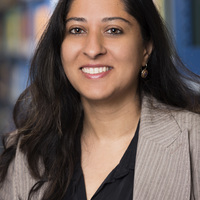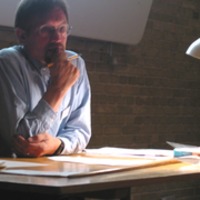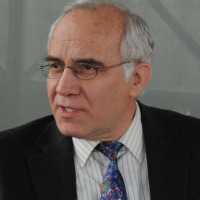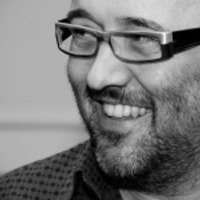Journal Articles & Book Chapters by Krzysztof E Borowski
Digital Humanities and Technology in Teaching Polish Language and Culture: Lessons from the COVID-19 Pandemic
Slavic and East European Journal, 2024

Social Media and Society: Integrating the digital with the social in digital discourse, 2023
With the rapid development of participatory social media, these spaces have become new arenas for... more With the rapid development of participatory social media, these spaces have become new arenas for producing political discourse. However, critical analyses of digital discourse that examine the importance of language typological variation for the (re)production of political discourse are relatively new. This chapter investigates linguistic creativity in non-elite political communication by combining a critical discursive approach with language typology. The analysis highlights the importance of language typology in political communication as political actors exploit the typological affordances of Polish. This chapter demonstrates how language affordances are mobilised for political reasons to (re)produce discriminatory political messages. The chapter suggests combining critical discourse analysis and language typology to reveal novel perspectives on the intersection of language and politics on the Internet.

Studies in Eastern European Cinema, 2023
The article presents an intertextual analysis of the first Polish Netflix-original series 1983 cr... more The article presents an intertextual analysis of the first Polish Netflix-original series 1983 created and written by Joshua Long. The series portrays fictional, dystopian Poland as a totalitarian state in which martial law never ended and the communist party remains in power. The analysis uses pivotal events from the series to draw connections between fictional Poland under martial law and post-2015 Poland ruled by the Law and Justice party. Close critical analysis and comparison of political discourse and visual imagery reveal how the socio-political situation in Netflix’s 1983 echoes real-world concerns about contemporary Polish socio-politics. The series functions as an intertextual commentary on post-2015 Poland, in which the Law and Justice government’s actions revived existing memories of civil protests and state oppression under martial law in communist Poland.
Slavia Centralis, 2022
This article surveys recent trends and directions in pragmatics and discourse analysis-related re... more This article surveys recent trends and directions in pragmatics and discourse analysis-related research of Slavic languages. Within the subfield of pragmatics, the article surveys studies of facework/(im)politeness, hate speech, speech acts, and pragmatics of emotions. The discourse analysis section surveys such topics as discourse markers, bilingualism, deixis, evidentiality and stance, humor, turn-taking, and critical discourse analysis (CDA) / critical discourse studies (CDS). The article also outlines areas in need of more research for Slavists-these include facework and power in institutional contexts, pragmatics and L2 learning of Slavic languages, and bilingual/multilingual discourse and pragmatics.

The Folk Linguistics of Silesian in Poland
V zeleni drželi zeleni breg: Studies in Honor of Marc L. Greenberg, 2018
This paper examines folk linguistic beliefs about what is and/or what makes a language in contemp... more This paper examines folk linguistic beliefs about what is and/or what makes a language in contemporary Poland by looking at an online conversation about the Silesian variety, traditionally classified as one of the main dialects of the Polish language. Using a folk linguistic approach, the present study analyzes metalinguistic talk in an online discussion forum from the perspective of standard language ideology. The analysis discusses a range of language concerns expressed by nonexperts who either support or reject the idea of Silesian as a separate language. The results suggest that discussants draw from a standard language ideology as they introduce and defend their positions in the debate, which implies that present-day Poland represents an example of the standard language culture.

Slavic Dialectology: A Survey of Research since 1989
The last 25 years in Slavic dialectology mark the period not only of JSL’s founding but also of m... more The last 25 years in Slavic dialectology mark the period not only of JSL’s founding but also of major and multiple political, social, and economic reorganizations in predominantly Slavic-speaking states. During this period research institutions and their priorities and projects have both continued and changed; technological innovation has meant moving towards electronic dissemination, “digital humanities,” and innovative modes of presenting research data and findings. In some cases major works (e.g., dialect atlases) have advanced during this period. Moreover, a new generation of scholars has had greater opportunities for mobility and therefore exposure to a variety of linguistic frameworks and approaches, which has fostered cross-border collaboration in the field. The present essay gives an overview of progress made on dialect projects both created institutionally and individually and including both traditional (book, article) and new digital means of dissemination.

O języku literackim molizańskich Słowian / On the Molise Slavic Literary Standard
This article aims to present and describe the situation of the literary language of the Molise Sl... more This article aims to present and describe the situation of the literary language of the Molise Slavs. In the last decades, various scholars have expressed their views on this issue with some of them claiming that Molise Slavic is a literary language, whilst by the other ones this vernacular was denied such right. Although Alexandr D. Dulichenko – who coined the term "Slavic literary microlanguage" – dated its literary traditions back to the 19th century, some scholars perceive the 18th or 20th centuries as the beginning of the literature written in Molise Slavic (MSl). Consequently, this led to ambiguity that this article is trying to clarify. Until recently, this vernacular was prevalently used for poetry and short prose, but with recent publications of Nicola Gliosca’s novels, Molise Slavic is now on its way to develop as a full-fledged literary language. According to typology presented by Antoni Furdal, MSl can now – with presence of translations – be classified as a "literary language with limited sphere of use."

Condemned to Extinction: Molise Slavic 100 Years Ago and Now
New Insights into Slavic Linguistics, 2014
ABSTRACT. This article is dedicated to the problem of vitality of Molise Slavic (MSl), a vernacul... more ABSTRACT. This article is dedicated to the problem of vitality of Molise Slavic (MSl), a vernacular spoken in Acquaviva Collecroce, Montemitro, and San Felice del Molise in the Italian region of Molise. In 1911, this idiom was condemned to extinction by Milan Rešetar. Although the local population kept diminishing significantly for the last 50 years, MSl was preserved from decay. With the latest revitalization efforts, lexicographical publications and first novels in na-našu, this vernacular has recently entered its fifth century on foreign soil. The UNESCO Atlas of World’s Languages in Danger classified MSl as “severely endangered”, and its current sociolinguistic situation (children being taught Croatian instead of Molise Slavic, rising lack of knowledge of MSl among them, declining population) confirms this assessment. Thus, reversing this situation so that na-našu is used in a large number of domains seems like a very challenging task for the users still speaking Molise Slavic on a daily basis.
Encyclopedia Entries by Krzysztof E Borowski
Critical Discourse Analysis
forthcoming
In: Marc L. Greenberg (ed.), Encyclopedia of Slavic Languages and Linguistics. Brill.
Silesian (in Poland)
Encyclopedia of Slavic Languages and Linguistics, 2020
Slavic Languages in the European Union
Encyclopedia of Slavic Languages and Linguistics, 2020
Web-Based Publications by Krzysztof E Borowski

George L. Mosse Program in History Blog, 2022
As a country made up of “three unequal halves,” to quote Stefan Żeromski’s famous statement from ... more As a country made up of “three unequal halves,” to quote Stefan Żeromski’s famous statement from his novel The Spring to Come (Pol. Przedwiośnie), interwar Poland was a place where regional differences were the foundation of its statehood, rather than a curious fact worthy of attention in tourist guides. With different currencies, divergent railroad networks, and distinct imperial legacies, the Second Polish Republic (1918–1939) had diversity inscribed into its very identity, forcing its political and bureaucratic elites to become diversity managers of their time. Diverse was also the country’s population, especially the one-third that wasn’t Roman Catholic and did not speak Polish as their first language. Volhynia (Ukr. Волинь, Pol. Wołyń, Yidd. װאָהלין), the setting of Kathryn Ciancia’s On Civilization’s Edge: A Polish Borderland in the Interwar World (Oxford University Press, 2020), is a case in point here. Nestled between present-day Belarus, Poland, and Ukraine, Volhynia was one of the linguistically, nationally, and religiously diverse regions in interwar Poland.
https://mosseprogram.wisc.edu/2022/06/13/borowski/
Translations by Krzysztof E Borowski
(Translation from Russian) Oleg V. Petrauskas Yuriy Bashkatov, Archaeology of the Early Slavs
Encyclopedia of Slavic Languages and Linguistics, 2019
(Translation from Russian) Andrii Skyba and Ievgen Synytsia, Archaeological Artifacts of the Slavs: 500–1000 CE
Encyclopedia of Slavic Languages and Linguistics, 2020
(Translation from Polish) Mirosław Jankowiak, Cekanne-Dzekanne
Encyclopedia of Slavic Languages and Linguistics, 2020
(Translation from Polish) Mirosław Jankowiak, Cokan’e
Encyclopedia of Slavic Languages and Linguistics, 2020
(Translation from Polish) Mirosław Jankowiak, Akan’e-Jakan’e
Encyclopedia of Slavic Languages and Linguistics, 2020
(Translation from Polish) Mirosław Jankowiak, Belarusian
Encyclopedia of Slavic Languages and Linguistics, 2020
Ph.D. Thesis by Krzysztof E Borowski

Online Conflict Discourse, Identity, and the Social Imagination of Silesian Minority in Poland
This dissertation shows how online discourse drives social change, boundary work, identity perfor... more This dissertation shows how online discourse drives social change, boundary work, identity performance, and, ultimately, community management (including in-group/out-group membership) by looking at the development and spread of popular nationalism on the internet. As people from outside of the political elites form online communities, they become politically active in online discussions on national (and regional) identity. In doing so, such online communities become communities of practice (Eckert 2006) that discuss recent events and larger issues, take sides, form coalitions, come up with idiosyncratic ways of discussing certain topics and people, and, finally, engage in a range of online behaviors that involve othering, narrativizing, and hateful speech. As a result, nationalism becomes a catalyst for the formation of online communities that emerge and coalesce around political goals, common language, and shared ideological stances. The dissertation examines how public discourse drives social change by looking at nonelite political actors become the ‘movers and shakers’ who radicalize themselves over the course of ongoing online discussions and then advance their ideological agendas by inciting radicalization among others. Finally, this work also analyzes the key role of language in the process of political radicalization in online spaces. The dissertation traces the emergence, coalescence, and maintenance of two such factions in the Western Daily discussion forum (Pol. Dziennik Zachodni, https://dziennikzachodni.pl), as evidenced in language use. Taking a sociolinguistic approach to internet discussions and applying a close, critical discursive reading of unstructured online conversations, the dissertation examines such phenomena as linguistic creativity, othering, narrativizing, and hate speech. All of these phenomena are crucial for identity struggles because it is through them that identities are constructed in the Western Daily forum. Given the context collapse (Marwick and boyd 2011), it is through language that members of the two warring communities can instantaneously identify each other as language becomes an immediate identifier of each participant’s stance toward the topic of the discussion. Not only language conveys intended meanings, but it also encodes pre-existing assumptions that people bring to the conversation, which is why methods of critical discourse analysis are well-positioned to uncover these meanings by focusing on language use.
https://kuscholarworks.ku.edu/handle/1808/30599











Uploads
Journal Articles & Book Chapters by Krzysztof E Borowski
Encyclopedia Entries by Krzysztof E Borowski
Web-Based Publications by Krzysztof E Borowski
https://mosseprogram.wisc.edu/2022/06/13/borowski/
Translations by Krzysztof E Borowski
Ph.D. Thesis by Krzysztof E Borowski
https://kuscholarworks.ku.edu/handle/1808/30599
https://mosseprogram.wisc.edu/2022/06/13/borowski/
https://kuscholarworks.ku.edu/handle/1808/30599